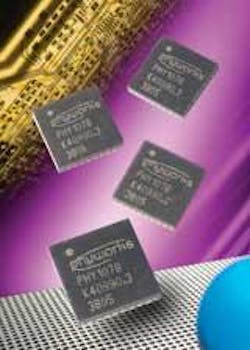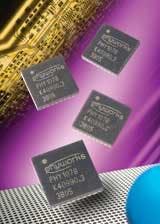Burst mode transceiver IC for GEPON, GPON systems
Integrating burst mode laser-driver and post-amplifier functionalities, the IC supports data rates between 155 Mbits/sec and 2.5 Gbits/sec, making the chip suitable for use in both GEPON systems based on the IEEE 802.3ah standard and GPON systems based on ITU G.984.2. “Most people have taken an existing laser driver and post amplifier and have reconfigured that using their own circuitry-and people have been able to ship systems doing that,” remarks Weaterton. “But the issue…is that they have a complex board which poses reliability issues, and they also have a costly implementation. They’re [also] typically using fairly old components [that] are not well suited to meet emerging standards and future requirements.”
Through the use of an “on-chip state machine,” the PHY1078 acts as a combined driver and receiver, allowing for the construction of optical modules without the need for a microcontroller. “It’s a good idea if it works OK, especially if they can do it more cost-effectively than two separate parts,” offers Hank Blauvelt, CTO at Xponent Photonics (Monrovia, CA), developer of surface-mount optical technology as well as joint reference designs for FTTX transceiver applications. “Those two functions are universally required, and historically they’ve mostly been separate. They’re pretty much independent functions, but you need both of them; it seems like a sensible thing to combine them.”
“If you take how you practically implement this, you would have all of those [components] anyway,” adds Weaterton. “The receiver would be a separate chip, the laser driver a separate chip; you’d normally have a microcontroller, and that’s in the state machine.”
The chip’s design provides a high-sensitivity receive path with crosstalk typically <0.2 dB. Weaterton notes that “one of the big hangups people have about a fully integrated product is, what’s the crosstalk going to be like? Everyone said to us, initially, ‘Surely that’s going to affect the sensitivity in the receive part as soon as you have this laser switching on and off.’ Those are the kinds of things that we technically had to overcome. We are primarily an analog house; as a result, things like arranging grounding systems…are the kinds of things that we’re good at. It really comes down to the chip-level device design, where we’ve overcome those problems.”
The chip’s transmit block includes a high-frequency modulator and laser bias current generator; bias current can be controlled by using either a burst mode automatic power control loop or an open loop mode based around a temperature lookup table. Driver parameters are set by on-chip registers, loaded from an external EEPROM. “The difference between this device and a normal laser driver is the burst mode capability,” observes Weaterton. “Both GPON and GEPON define different standards for the burst, so we had to design the device with a very fast turn-on. The turn-on time in GEPON defines that you have about 12.8 nsec to turn the laser on; our device achieves something around 3 nsec.”
The PHY1078 is currently sampling, with volume production expected next month.
